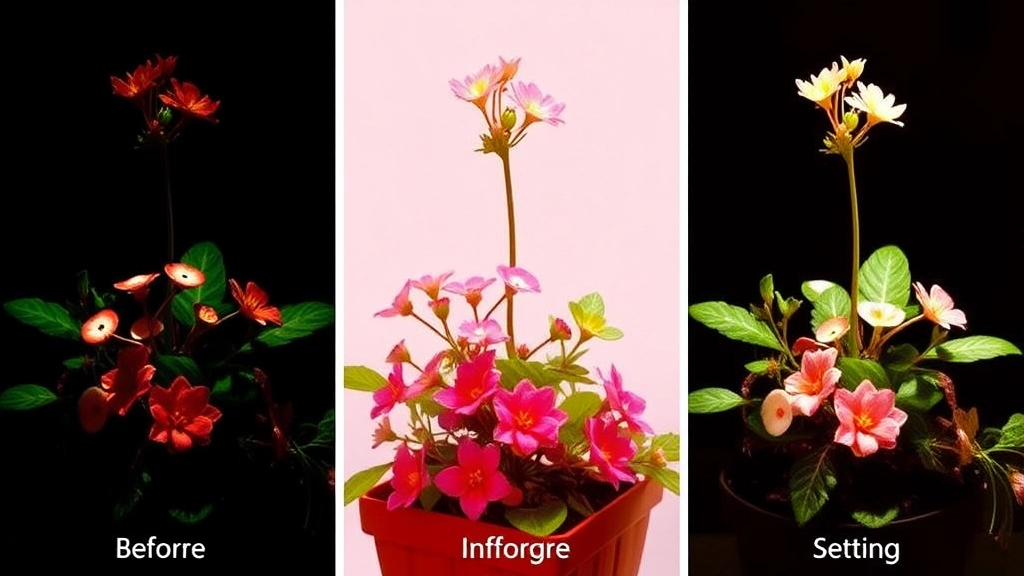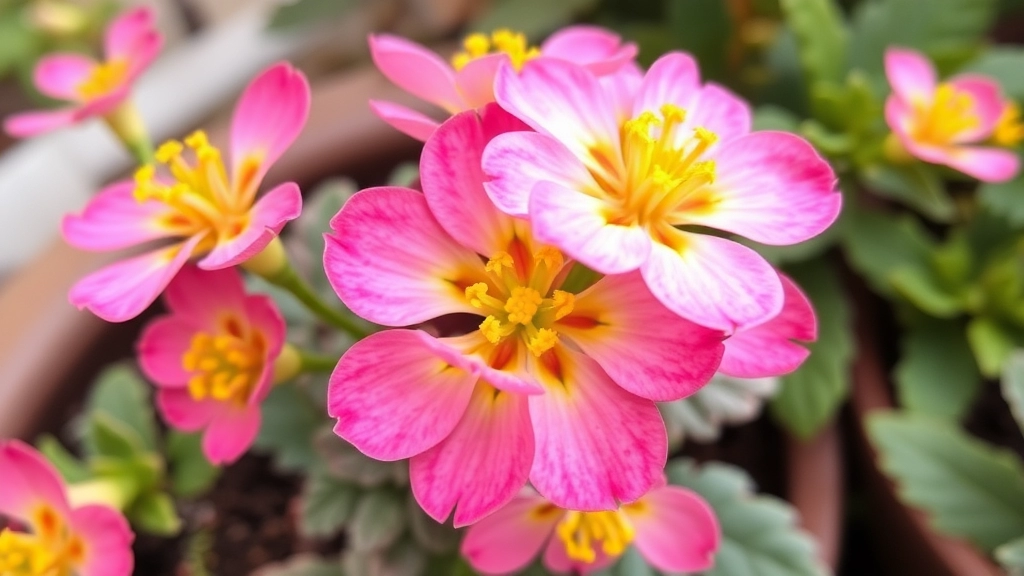Kalanchoe Blossfeldiana: Indoor vs. Outdoor Growth
Are you wondering whether to grow your Kalanchoe Blossfeldiana interior or exterior? This versatile plant thrives in both settings, but there are key differences to consider. Indoors, it enjoys consistent temperatures and controlled lighting, making it easier to manage. Outdoors, it benefits from natural sunlight but may need protection from extreme weather.
Lighting Conditions
Understanding the ideal lighting conditions is crucial. Indoors, place your Kalanchoe Blossfeldiana near a bright window to mimic its natural environment. Outdoors, ensure it gets plenty of sunlight but provide shade during the hottest parts of the day. Each setting has its unique requirements, so choose the one that best fits your lifestyle and local climate.
Indoor vs Outdoor Conditions
- Light Exposure
Indoors: Kalanchoe requires bright, indirect light. Too much direct sunlight can scorch the leaves.
Outdoors: It thrives in full sun, but during the hottest parts of the day, some shade may be beneficial. - Temperature Control
Indoors: Typically, indoor temperatures remain stable, which is ideal for Kalanchoe.
Outdoors: Outdoor plants face fluctuating temperatures and may need protection from extreme heat or cold. For more details, you can refer to the ideal temperature for Kalanchoe Blossfeldiana growth. - Humidity Levels
Indoors: Often, indoor environments are drier, so occasional misting can help.
Outdoors: Natural humidity levels may be higher, but it’s essential to ensure good air circulation to prevent rot. Learn more about the optimal care for Kalanchoe Blossfeldiana growth. - Watering Frequency
Indoors: The soil dries out slower, so watering should be less frequent.
Outdoors: Rain and evaporation can affect moisture levels, requiring more regular checks. - Pest Management
Indoors: Fewer pests, but watch for common indoor nuisances like mealybugs.
Outdoors: Vulnerable to a wider range of pests and diseases, necessitating more vigilant monitoring.
Ideal Lighting Conditions for Kalanchoe Blossfeldiana in Various Settings

So, you’ve got your Kalanchoe Blossfeldiana, and you’re probably wondering about the best lighting conditions for it, right? Whether you’re nurturing it indoors or letting it bask outdoors, light is key to keeping this beauty thriving.
Indoor Lighting Needs
For indoor settings, Kalanchoe loves bright, indirect light. Here’s what you should keep in mind:
- Location: A south or east-facing window is ideal.
- Duration: Aim for about 6 hours of light a day.
- Supplemental Lighting: If your space is a bit dim, consider using grow lights to give it that extra boost.
Too much direct sunlight can scorch those lovely leaves.
Outdoor Lighting Needs
When it comes to outdoor care, Kalanchoe enjoys a different vibe:
- Partial Shade: It thrives in spots with morning sun and afternoon shade.
- Sunlight Duration: About 4-6 hours of sunlight works wonders.
- Avoid Intense Heat: If it’s a scorcher outside, try to protect it from the harshest rays.
You want to strike a balance between sunlight and shade to keep your Kalanchoe happy.
When it comes to watering Kalanchoe Blossfeldiana, the approach varies significantly between indoor and outdoor environments. Understanding these differences can make all the difference in keeping your plant healthy and vibrant.
### Indoor Watering Techniques
For indoor Kalanchoe, the key is to mimic their natural dry environment. Here are some effective strategies:
– **Frequency**: Water every 2-3 weeks, allowing the soil to dry out completely between waterings. This prevents root rot, a common issue for indoor plants.
– **Method**: Use a pot with drainage holes. Water thoroughly until it drains out of the bottom, then empty the saucer to avoid water sitting at the base.
– **Humidity**: Indoor air can be dry, especially in winter. Consider using a pebble tray filled with water to increase humidity without directly wetting the plant.
– **Signs of Overwatering**: Yellowing leaves or a mushy stem indicate too much water. Adjust your watering schedule accordingly.
For more detailed guidance, check out our [complete care guide for Kalanchoe Blossfeldiana succulent](https://planthq.org/complete-care-guide-for-kalanchoe-blossfeldiana-succulent/).
### Outdoor Watering Techniques
Outdoor Kalanchoe Blossfeldiana, on the other hand, needs a bit more flexibility due to environmental factors:
– **Frequency**: Water every week during dry spells, but reduce frequency during rainy seasons. Always check the soil moisture first.
– **Method**: Water at the base of the plant to prevent fungal issues. A soaker hose or drip irrigation system can be effective for consistent moisture.
– **Soil Type**: Well-draining soil is crucial outdoors. If your soil retains too much moisture, consider amending it with sand or perlite.
– **Signs of Underwatering**: If the leaves become wrinkled or shrivelled, it’s time to give your outdoor Kalanchoe a drink.
For more insights on soil requirements, visit our page on the [best soil for Kalanchoe Blossfeldiana care tips](https://planthq.org/best-soil-for-kalanchoe-blossfeldiana-care-tips/).
Best Soil and Potting Practices for Kalanchoe Blossfeldiana in Both Environments

When it comes to nurturing Kalanchoe Blossfeldiana, the right soil and potting practices can make all the difference. Whether you’re growing them indoors or outdoors, ensuring optimal conditions is key to their health and vibrancy.
Soil Requirements
Kalanchoe Blossfeldiana thrives in well-draining soil. Here are some essential points to consider:
- Soil Type: A cactus or succulent mix is ideal. These blends provide the drainage needed to prevent root rot.
- pH Level: Aim for a slightly acidic to neutral pH, typically between 6.0 and 7.0.
- Additives: Consider adding perlite or coarse sand to improve drainage. This is especially important for indoor plants that may retain more moisture.
Potting Practices
The pot you choose can significantly impact your Kalanchoe’s growth. Here’s what to keep in mind:
- Container Choice: Opt for pots with drainage holes. This helps excess water escape, reducing the risk of overwatering.
- Size Matters: Choose a pot that’s just slightly larger than the root ball. Too much extra space can lead to water retention.
- Repotting: Repot every couple of years or when the plant outgrows its container. This refreshes the soil and provides room for growth.
Indoor vs Outdoor Considerations
While the basics remain the same, there are some nuances based on your growing environment:
- Indoors: Ensure that the potting mix is lightweight to facilitate easy movement and better drainage.
- Outdoors: You may want to amend garden soil with sand or gravel for improved drainage, especially in clay-heavy areas.
Common Problems and How to Address Them for Indoor and Outdoor Kalanchoes
Growing Kalanchoe Blossfeldiana can be a rewarding experience, but it’s not without its challenges. Whether you’re nurturing these vibrant plants indoors or outdoors, you may encounter some common issues. Let’s explore how to tackle these problems effectively.
1. Overwatering and Root Rot
Indoor Kalanchoes are particularly susceptible to overwatering, which can lead to root rot. Signs include yellowing leaves and a mushy stem. To combat this:
- Check the Soil: Always ensure the top inch of soil is dry before watering.
- Use Well-Draining Soil: A cactus mix or a blend with perlite can help.
- Adjust Watering Frequency: In winter, reduce watering as the plant enters dormancy.
Outdoor Kalanchoes need careful monitoring too. Heavy rains can saturate the soil.
- Create Drainage: Plant in raised beds or pots with drainage holes.
- Mulch: This helps regulate moisture levels.
2. Pests
Both indoor and outdoor Kalanchoes can attract pests like mealybugs and aphids.
- Inspect Regularly: Look for sticky residue or webbing on leaves.
- Use Natural Remedies: A mixture of water and mild soap can deter pests.
- Neem Oil: This is effective for both prevention and treatment.
3. Leaf Drop
If your Kalanchoe is shedding leaves, it could be due to stress from temperature changes or lack of light.
- Indoor Solutions: Ensure your plant is near a bright window but not in direct sunlight.
- Outdoor Solutions: If temperatures drop, consider bringing your plant inside or covering it with frost cloth.
4. Fading Blooms
Kalanchoes are known for their stunning flowers, but they can sometimes fade prematurely.
- Provide Adequate Light: Ensure they receive at least six hours of indirect sunlight daily.
- Fertilize: Use a balanced fertiliser during the growing season to encourage blooming.
- Deadheading: Remove spent flowers to promote new growth.
5. Etiolation
Indoor Kalanchoes can become leggy if they don’t receive enough light.
- Rotate Your Plant: This encourages even growth.
- Supplement with Grow Lights: If natural light is insufficient, consider using grow lights.
By being proactive and attentive, you can prevent many of these common issues. For more detailed care tips, check out our lighting and care guide or explore the complete care guide for Kalanchoe Blossfeldiana.
Seasonal Considerations: Protecting Kalanchoe Blossfeldiana from Extreme Temperatures
Are you worried about your Kalanchoe Blossfeldiana surviving the harsh winter chill or the scorching summer heat?
These vibrant plants can thrive beautifully indoors and outdoors, but they need a little extra care when the seasons change.
FAQs for Kalanchoe Blossfeldiana: Interior and Exterior Care
What are the ideal lighting conditions for Kalanchoe Blossfeldiana indoors?
Kalanchoe Blossfeldiana thrives in bright, indirect light when grown indoors. Ideal locations include south or east-facing windows, aiming for about 6 hours of light daily. If the light is insufficient, consider using grow lights.
Can Kalanchoe Blossfeldiana be placed in direct sunlight indoors?
No, too much direct sunlight can scorch the leaves of your Kalanchoe Blossfeldiana. It’s best to provide bright but indirect light.
What are the outdoor lighting needs for Kalanchoe Blossfeldiana?
Outdoors, Kalanchoe Blossfeldiana thrives in partial shade, with morning sun and afternoon shade. Aim for about 4-6 hours of sunlight daily, but protect it from intense heat and harsh rays.
What type of soil is best for Kalanchoe Blossfeldiana?
Kalanchoe Blossfeldiana prefers well-draining soil, ideally a cactus or succulent mix. The soil should have a slightly acidic to neutral pH, between 6.0 and 7.0. Adding perlite or coarse sand can help improve drainage.
How should I choose a pot for my Kalanchoe Blossfeldiana?
Select a pot with drainage holes to allow excess water to escape, reducing the risk of overwatering. The pot should be slightly larger than the root ball to prevent water retention. Repotting every couple of years is recommended to refresh the soil and provide room for growth.
Are there different potting practices for indoor and outdoor Kalanchoe Blossfeldiana?
Yes, while the basics remain the same, indoor plants benefit from a lightweight potting mix for easier movement and better drainage. For outdoor plants, amend garden soil with sand or gravel to improve drainage, especially in clay-heavy areas.
How often should I repot my Kalanchoe Blossfeldiana?
Repot your Kalanchoe Blossfeldiana every couple of years or when it outgrows its current container. This helps refresh the soil and provides additional room for growth.
Can I use regular potting soil for Kalanchoe Blossfeldiana?
Regular potting soil is not ideal as it may retain too much moisture, leading to root rot. It’s best to use a cactus or succulent mix to ensure proper drainage.
What should I do if my indoor space is too dim for Kalanchoe Blossfeldiana?
If your indoor space lacks sufficient light, consider using grow lights to supplement the natural light and help your Kalanchoe Blossfeldiana thrive.
Is it necessary to amend garden soil for outdoor Kalanchoe Blossfeldiana?
Yes, especially if your garden soil is clay-heavy. Amending it with sand or gravel can significantly improve drainage, which is crucial for the health of your Kalanchoe Blossfeldiana.
References
-
Growing Guide for Kalanchoe Blossfeldiana
-
Kalanchoe Light Requirements
-
Kalanchoe Care Guide
